Why Is My Check Engine Light Flashing and Car Shaking Violently?
The check engine light blinking wildly as the car shakes likely signals engine misfires. Misfires take place when fuel fails to ignite in one or multiple cylinders. This happens when parts like spark plugs, ignition coils, fuel injectors, or vacuum hoses fail. The inefficient burning makes the engine tremble. Immediately stop operating the vehicle. Plug in an OBD2 scanner to read diagnostic trouble codes. This will reveal the real issue. Making repairs right away is crucial. Driving with misfires can severely harm expensive components like pistons, the catalytic converter, and oxygen sensors. Tackling ignition and fuel system problems quickly can bring back smooth engine performance. It also prevents costly repairs down the road.
That blinking check engine light is trying to tell you something. When it flashes as your car shudders, it means there’s an urgent issue that needs fixing fast.
While alarming, don’t panic. This guide walks you through diagnosing the problem step by step.
Ignoring the blinking light risks breakdown or a big repair bill later. But catching the issue now means less cost and hassle. So, let’s get started.
I’ve another helpful guide on car running fine despite check engine light. You should also check that out.
In the last section, I’ve included comments from forums where users share firsthand experiences with a blinking check engine light and car shaking. Be sure to check out that section for real insights.
If you have some preliminary knowledge, you can jump straight to the causes section.
- Engine misfire causes check engine light flashing and car shaking due to uneven combustion.
- Ignition system problems like bad coils and spark plugs are common culprits for car shaking and blinking check engine light.
- Fuel system defects from clogged injectors can also lead to engine misfires and car shaking.
- Intake leaks disrupt air-fuel ratio and cause performance issues.
- Emissions components like EGR and EVAP valves going bad affects combustion which can lead to the check engine light.
- Driving with flashing check engine light risks damaging pistons, catalytic converter and other components.
What To Do If Check Engine Light Is Blinking?
You need to have an OBD2 scan tool that can read all trouble codes stored in the engine’s memory. This will help you understand which area of your engine you should inspect first that is causing engine misfire.
Generally, users observe the P0300 code on the scan tool which indicates that misfiring is occurring randomly in engine cylinders.
OBD2 tool can also code specific code like P0303 which means that a misfire has occurred in cylinder#3. In that case, swap the ignition coil and spark plug between cylinder three and another cylinder to see if the miss moves or stays where with cylinder#3.
Common Causes Of Check Engine Light Flashing And Car Shaking
1. Bad Fuel Injectors Fail To Deliver Appropriate Amount Of Fuel
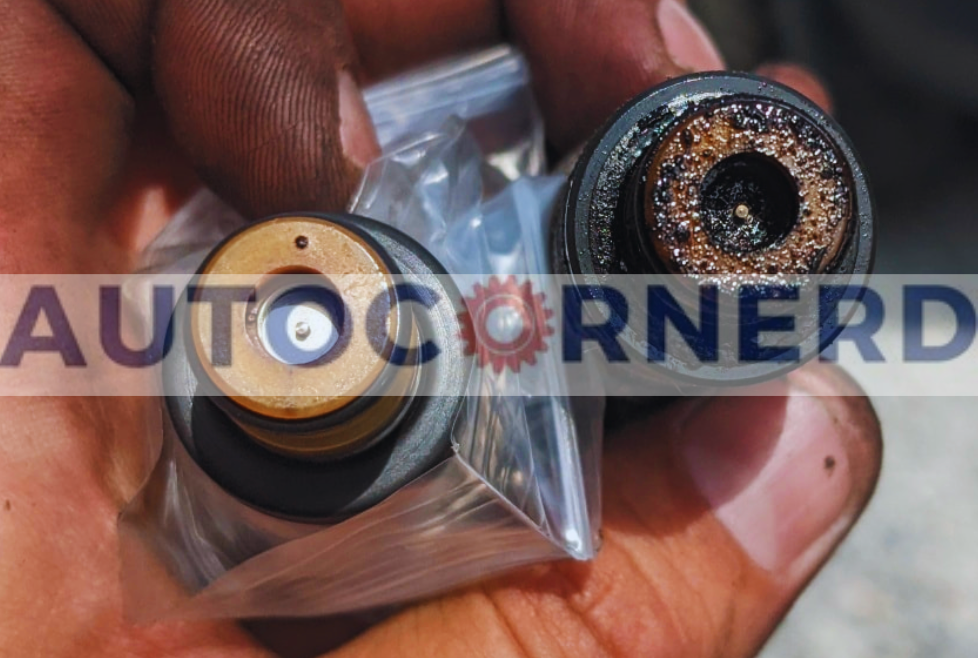
The fuel injectors are basically electromagnetic solenoid valves that get magnetized when the ECU commands to send the current.
When a fuel injector gets the current, the solenoid valve opens and fuel is injected in an atomized form in a very controlled manner.
Now, modern gasoline engines have adopted direct injection technologies that directly inject highly-pressurized fuel into the combustion chamber so that it readily atomizes and mixes with the air for even combustion.
With time, fuel injectors become clogged with carbon deposits or also become stuck open, due to which they fail to inject atomized fuel at the right time. When the fuel injector is bad, it can cause the mixture of air and fuel to be uneven, leading to problems with combustion.
The problem of a faulty injector could also be caused by a weak electrical connection between the injector and the ECU.
How to test bad fuel injectors?
There are different tests to check the fuel injectors. First, we have to check the O-rings on the top and bottom of the fuel injector as a leaky fuel injector will fail to deliver sufficient fuel to the engine cylinder and could cause a misfire.
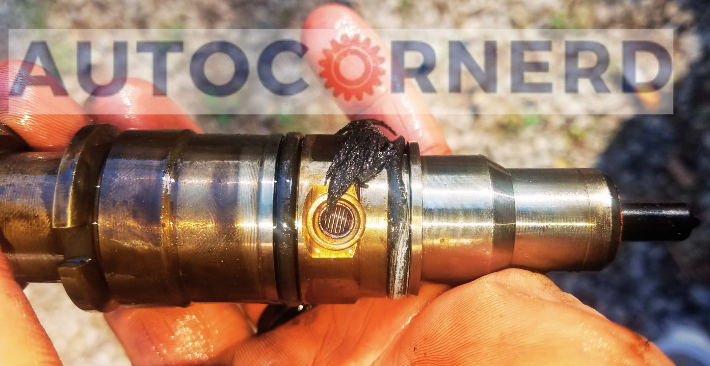
Next, we have to perform an electrical test on each fuel injector to see if it’s clicking or not. After that, a mechanical test is done on the fuel injectors to observe whether they are injecting fuel at a right angle.
I have written another detailed guide on car won’t start after replacing fuel injector. You should read that guide to learn about different tests done on a fuel injector.
Moreover, in that guide, I have also discussed a procedure to check the electrical connection of the fuel injector.
2. Bad Ignition Coils Trigger Engine Light and Rough Idling Due to Spark Plug Misfires
A bad ignition coil is one of the most common causes of shuddering car and blinking check engine light. Ignition coils supply high voltage to the spark plugs to initiate combustion in the engine.
An ignition coil consists of two types of winnings:
- Primary winding
- Secondary winding
The primary winding is connected to the 12V of the battery via the engine control module. The secondary winding is connected to the spark plug to generate a spark.
Now, the configuration of an ignition coil depends on the vehicle model. There are three configurations of an ignition coil:
- Distributor system
- Coil Pack
- Coil On Plug (COP)
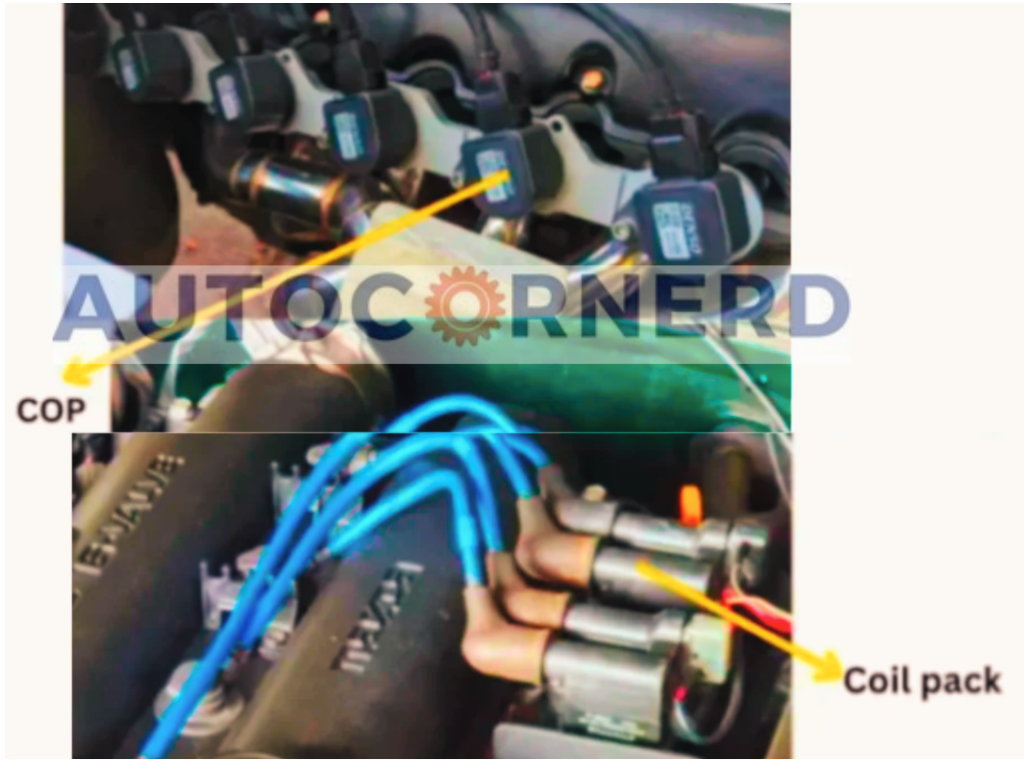
The distributor system has only one ignition coil controlling all ignition in all cylinders. Such distributor systems can be found in 4.3L Vortec engines. In a distributor ignition system, the primary winding is wrapped around the core, while the secondary winding is attached to the distributor cap.
This type of ignition system with a distributor is complex and difficult to maintain as we have contact breaker points in the distributor system that erode over time. Moreover, inside the distributor cap, carbon builds up over time, which also affects the resistance of the electrical path from the secondary coil to the spark plug. I found this document (PDF) really helpful to get an idea about all possible issues in the distributor ignition system.
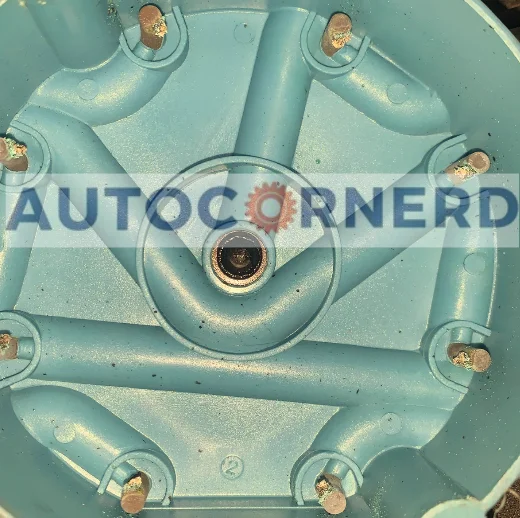
In some engines, there is a coil pack instead of a distributor. It is also called the ‘Wasted Spark Ignition System’. Each coil pack consists of two or more coils. Each coil pack controls spark plugs ignition in two or more cylinders.
So, if your engine has 6 cylinders, there will be three ignition coil packs. In the picture below, you can see a coil pack to control the sparks in the four cylinders. It has four terminals (two on each side) controlling the four cylinders.
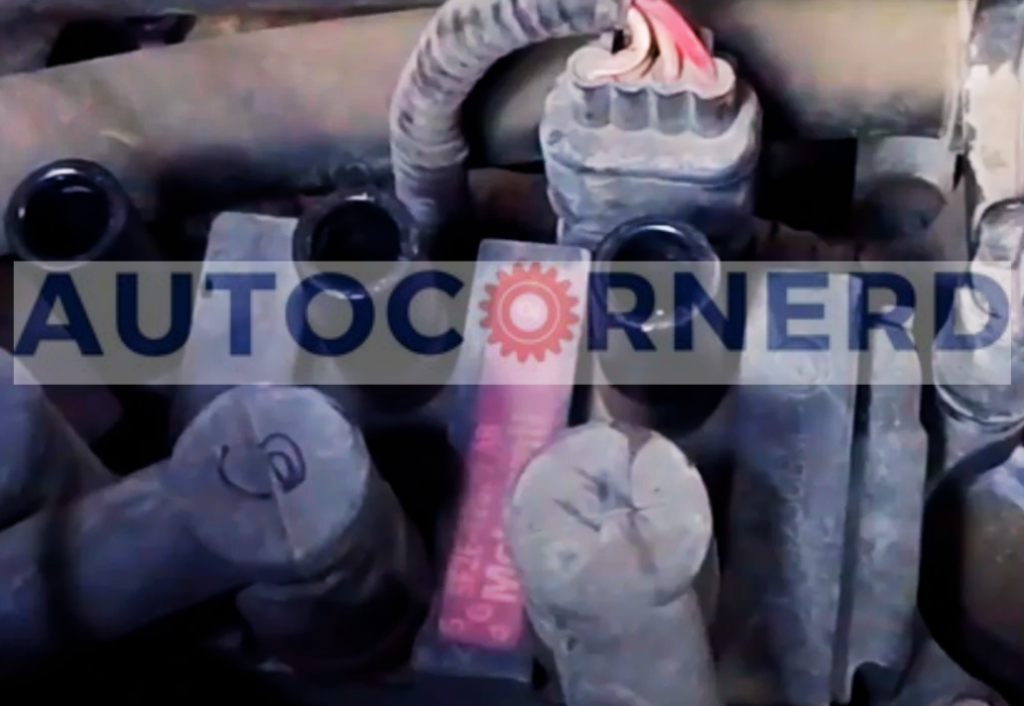
The last type is Coil On Plug, which is present in modern engines. In this configuration, each cylinder has its ignition coil on which the spark plug is tightened. Such ignition coils have two, three, or four-wired configurations.
You can check that by counting the pins in the port where the electrical connector is plugged. If you look at the ignition coil in the picture below, it is three-wired.

If the ignition coil is short at some point, it will cause intermittent car starting failures.
How to diagnose bad ignition coil?
To diagnose an ignition coil, you have to measure the resistance across positive and negative terminals of both primary and secondary coils of ignition coils in each cylinder.
You can find the optimal resistance values of an ignition coil in its specs or service manual. The resistance across terminals of the secondary coil is in thousands of ohms and resistance across terminals of the primary coil should be less than 1ohm.
3. Bad Spark Plugs Leading To Engine Misfires
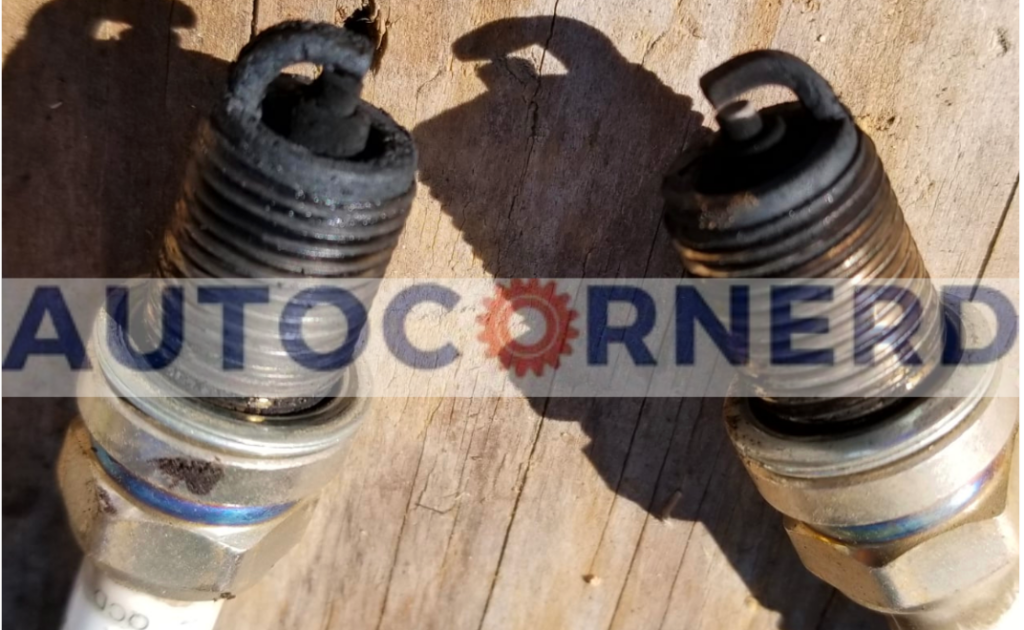
If spark plugs are not igniting properly or are damaged, your engine may experience problems. These problems can lead to checking engine light flashing, engine shaking, or rough idle.
Spark plug becomes bad due to the following things:
- The gap between the spark plug center (tip) and the side electrode is not properly sized. Maybe the electrode is pushed down.
- Porcelain (white-coating of insulation) is not sealed properly. Due to poor fitting or worn insulation of spark plug, you will see black burn signs that occur due to the current discharge from the top terminal of the spark plug, down the outside of the insulator.
- Deposits of burning oil, ash, or fuel on the tip of the spark plug. Such deposits on spark plugs are built up due to imbalances in air/fuel ratio or bad fuel injectors.
I have found this amazing guide (bad spark plug signs PDF) that includes pictures of all possible damages with the spark plug.
How to test bad spark plugs?
You can test spark plugs by using a multimeter and setting it to resistance measurement. You should get a reading between 4,000 to 8,000 ohms on the center electrode.
In addition, you should look for a short between the ground and center electrode of the spark plug. No short means a good spark plug.
You can watch following youtube video to learn more:
How to fix fouled spark plugs?
You can try cleaning the spark plugs using the wire brush and spark plug cleaner to carefully remove any carbon deposits or contaminants from the electrode. Ensure not to damage the electrode or insulator in the process.
First, use compressed air to clean off any dirt and debris. Then, keep the spark plug soaked in the brake cleaner till all the gunk on the spark plug is washed away. If the spark plug still doesn’t ignite properly, you need to replace it.
4. Bad Variable Valve Timing System (VVT) Causing Inefficient Combustion
The engines in today’s cars have a special system called VVT. VVT stands for Variable Valve Timing. This system helps change when the engine valves open and close as the engine speed changes.
Inside the engine are parts called cam phasers. Their job is to pass along the spinning motion from the crankshaft to open and close the valves at just the right time. The cam phasers connect to the valves through the camshaft and timing chain.
The engine computer (ECU) tells a little solenoid valve to let pressurized oil flow to the cam phasers. This oil moves the cam phasers so they can make the valve timing happen sooner or later, depending on how fast the engine is spinning.
You can follow the following YouTube video for the test of the VVT solenoid valve:
In addition to the VVT solenoid, a bad cam phaser also causes the engine to misfire and flashes the check engine light. You may also need to replace it.
5. Poor Engine Oil Quality
A low-quality oil can cause engine problems. The wrong oil viscosity, quality, or additives can cause issues like:
- Check Engine Light Illumination
- Engine Knocking or Ticking
- Reduced Fuel Economy
- Oil Leaks
- Excessive Engine Wear
- Engine Overheating
Oil operates control valves in the VVT system and helps keep the engine clean by preventing sludge. If you have not changed your engine oil for more than 5000 miles, you should consider changing the oil at first. You can use the dipstick to see the color of the oil.
A bad oil is dark or black in color and is thicker due to engine deposits. Also, make sure that there is optimum oil pressure in the engine. Check my guide on low oil pressure at idle for more details.
6. Bad Engine Sensors
Bad engine sensors (MAF, O2, CKP, Camshaft) can also cause engine light flickering and vehicle trembling due to engine misfire.
A car can have either MAF or MAP sensor. It depends on your engine. PCM uses readings for MAP and Throttle Position Sensor to measure the fuel amount to be injected.
MAF sensor calculates the volume of airflow and sends this information to the ECU to measure the fuel amount. Air passes through the MAF sensor before entering the throttle body so that ECU can adjust the air/fuel ratio and opening of the throttle body.
The CKP sensor measures the position and speed of the crankshaft. ECU needs this information to control valve timing, ignition timing, and fuel injection.
You can read my guide on car won’t start after replacing crankshaft sensor. O2 sensor calculates unburnt oxygen in emissions and sends this information to PCM to determine desired air/fuel ratio.
How to test a bad oxygen sensor?
The oxygen sensor in your car generates voltage that changes when the air and fuel mixture changes. This voltage should go up and down at least once every couple seconds. It should be between about 850 mV and 150 mV.
If the oxygen sensor stops working right, the voltage might not go up and down anymore. Or the levels might be weird and too high or too low. This could make your engine run badly.
To check the O2 sensor, use a voltmeter. Put the red wire on the sensor’s signal wire. Put the black wire on a ground part of the engine.
Watch the voltage readings. If they stay stuck or don’t switch between high and low, the sensor is probably broken.
How to test a bad MAF sensor for a blinking check engine light?
As the mass flow rate of air through the MAF sensor increases, voltage output also increases.
When you push the gas pedal, more air goes through the MAF sensor. This makes the voltage go up.
When the car is not moving much, the voltage should be less than 1.0V. When you make the car go faster, the voltage from the MAF sensor goes up from 1.0V to 1.7V.
If the voltage of the MAF sensor is fluctuating, you can clean that heated element of the MAF sensor using this cleaner. Be sure to never touch that wire of the MAF sensor. Let it dry completely before re-installing the sensor.
Here is a short Youtube video explaining how to clean the MAF sensor.
7. Vacuum Leaks Affecting Air-Fuel Ratio
The engine needs the perfect mix of air and fuel to run nice and smooth. But when there’s a vacuum leak at idle, it brings in “unmetered air” that doesn’t get measured. This air sneaks in like an uninvited guest to a party, completely uncounted.
The MAF sensor can’t see this surprise guest. So all this unmeasured air causes trouble with keeping that smooth balance in the engine.
When the piston moves down to let the air-fuel mix into the cylinder, it makes a vacuum. This vacuum then sucks in the air needed for combustion when the intake valve opens.
Stepping on the gas makes the throttle plate open more, letting more air reach the party down in the cylinder. So when you accelerate, the vacuum gets less. But when idling, the vacuum is at full force.
Any leak at idle brings that uninvited air right on in. And this unmetered air messes up the fuel-air ratio, sometimes making the engine stall or shut off without warning.
Unmetered means unchecked – this air got in without the MAF sensor taking attendance. So it throws the engine’s smooth running off balance.
Vacuum Leaks Causes
- Cracked or Leaking Intake Manifold: A vehicle’s intake manifold is like a large pipe carrying air to each cylinder. But cracks can start forming in those walls over time, creating unwanted air pockets. Air gets dragged to places it shouldn’t go, throwing off balance. Regular check-ups to inspect for damage allow catching issues before they worsen. Putting on shiny new manifolds keeps everything sealed up tight.
- Worn or Damaged Intake Manifold Gaskets: Intake manifold gaskets lie squeezed between the manifold and engine to prevent air escaping. Though heat and vibration may cause them to crack or wear thin as the miles add up. Damaged gaskets permit air to sneak out or seep inside, altering the air-fuel mixture and harming performance.
- Faulty Vacuum Hoses: Vacuum hoses carry air around the engine from A to B. If any grow cracks or leaks, it’s effectively punching holes in the system. Untracked air slips through those holes, resulting in a vacuum leak. Swapping out damaged hoses keeps air flowing where it ought to.
How to detect vacuum leaks that cause your car to shake?
Listen carefully for a hissing sound when your engine runs to find a vacuum leak. The high-pitched hiss gives away the problem area to start your search.
Specialized smoke machines locate even sneaky leaks for professionals. Smoke forces inside the intake system. Escaping wisps of smoke point straight to cracks and gaps. But everyday mechanics lack these fancy tools. The hissing sound remains a trusty clue.
Another method involves using carb cleaner to identify vacuum leaks in the engine.
8. Bad EGR Valve Causing Higher Inflow of Exhaust Gases
A bad EGR valve can also cause car shaking and blinking of the check engine light.
The EGR valve is used to reduce emissions by recirculating exhaust gas back into the combustion chamber. It helps reduce the combustion temperatures and the number of NOx gases in the engine exhaust.
The temperature of combustion is reduced because less oxygen is used from the air for combustion.
How EGR valve becomes bad?
A frequent problem with the EGR valve is that it is often stuck due to a build-up of carbon deposits.
The EGR valve passages are blocked by the carbon deposits. Blocking the EGR valve can increase fuel consumption and reduce engine performance, which can turn on the check engine light.
How to test EGR valve?
If your EGR valve is malfunctioning, the OBDII scan tool will display P0400, P0401 or P0402 error codes.
Now, remove the EGR valve and perform a visual inspection to check for any cracks or holes in the housing. A cracked or damaged EGR valve will need to be replaced.
To check if the EGR valve is working correctly, we will now use a hand-operated vacuum pump.
If the EGR valve can hold a vacuum, it indicates that the valve is functioning properly. However, if the vacuum pressure drops off after a while, it suggests a faulty EGR valve that needs to be replaced.
9. Bad EVAP Valve Causing More Fuel Vapors
EVAP solenoid valve is used in the fuel emission control system. EVAP valve is a one-way electronically controlled solenoid valve that can cause engine misfire and car shaking if it is stuck open.
When the EVAP valve is stuck open, excessive fuel vapors are sucked into the combustion chamber.
As a result, the air-fuel mixture becomes rich and causes incomplete combustion. If you have a Ford vehicle, you can see the P1450 code on the OBD2 scan tool if the EVAP valve is bad.
You can watch the below video to test the EVAP valve:
10. Loss Of Compression
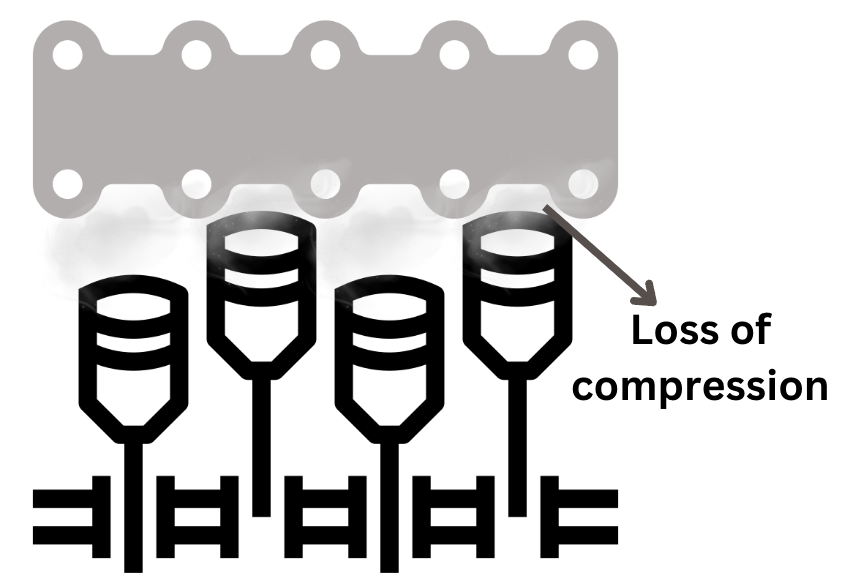
The squeezing of the air/fuel mix in the cylinder before the spark lights it is called compression. This squeezing makes the pressure needed for the fuel to burn and power the engine.
The compression stroke squeezes the air and fuel in the cylinder. Then the spark plug ignites it to make power.
If there is a loss of compression the engine’s power will go down. It will run poorly. So the fuel won’t burn well. A misfire will happen. The check engine light will start flashing.
Some things can cause a loss of compression. They are:
- Worn piston rings: The rings seal the burning chamber. They keep the air/fuel from leaking out. Over time the rings can wear out. They lose their sealing ability. This causes a loss of compression. It can happen from poor vehicle maintenance, high mileage or overheating.
- Damaged cylinder walls: The walls give a smooth surface for the rings to slide on. If the walls get damaged, the rings can’t seal the chamber anymore. This leads to lost squeezing. It can happen from overheating, poor lubrication or dirty oil.
- Leaky valves: The valves control the air and fuel flow in and out. If the valves are damaged or worn, they can leak the air/fuel out. This causes a loss of compression. It can happen from overheating or dirty oil.
- Blown head gasket: The gasket seals the cylinder head to the engine block. It keeps the air/fuel from leaking out. If the gasket blows, it can let the mix leak out. This leads to lost compression.
- Cracked cylinder head or block: If the head or block cracks, it can let the air/fuel leak out. This also causes a loss of compression.
- Bad timing chain/belt: The timing chain syncs the valve opening and closing. If the chain wears or stretches, the valve timing gets off. The valves open and close at the wrong time. This can make the engine lose compression ratio.
To learn more about head gasket failure and leaking of valves, you can read my guide on car won’t start after overheating.
How to spot?
Follow these steps to perform a compression test to detect loss of compression in engine:
- First, disconnect the electric connectors of the fuel pump, fuel injectors and ignition coils/distributor.
- Remove all spark plugs. Use a suitable spark plug socket to remove spark plugs.
- For the first cylinder, screw the compression gauge in the hole where the spark plug goes.
- Turn on the ignition and depress the accelerator pedal fully to keep the throttle plate open.
- Crank the engine up to 5 times or do it until the needle on the compression gauge is peaked and doesn’t climb anymore. If you have a push start/stop button, press brake pedal and push the button multiple times.
- Note down the pressure reading for each cylinder on a piece of paper. If you don’t know how cylinders are numbered in the engine, you can read this guide.
- If one of the pressure readings is significantly lower, it can indicate a problem with that single cylinder.
- If you only have a low reading on one engine cylinder or the cylinders aren’t adjacent to each other, the issue is with the valve seal or piston ring.
- If adjacent cylinders have low-pressure readings, the issue might be with the head gasket.
- When all your pressure ratings inside the engine cylinders are below 100 PSI for gasoline engines or below 275 for diesel, you may have a valve timing issue, or piston rings are worn-out.
- To determine worn-out piston rings, a wet compression test is performed. The wet compression test involves adding a small amount of oil through a spark plug hole to see if the compression reading improves, which can help determine whether the low compression is due to piston rings or valves.
- If the compression reading improves, it suggests that the low compression reading was due to worn-out piston rings. When oil is added to the cylinder, it acts as a lubricant and seals off the gaps between the piston rings and cylinder walls, leading to improved compression readings.
What Causes A Blinking Check Engine Light and Car Shaking?
An engine misfire causes check engine light starts flashing angrily and suddenly your car starts shaking like it’s auditioning for a horror movie.
When an engine misfires, one or more cylinders don’t fire properly, usually because of issues with the ignition system. This means your engine can stall, lose power, and shudder as if possessed by a demon.
For smooth driving, engines need a few things working just right:
- Perfect timing of ignition
- Just the right air to fuel ratio
See, your engine goes through a bunch of little explosions to keep things moving. It has to inject fuel and spark plugs need to ignite at exactly the right moment based on the engine’s position. So when something messes up that timing or fuel ratio, some cylinders don’t properly explode, and bam – misfire.
Misfires happen when spark plugs don’t light up on time, often because of a faulty ignition coil failing to zap them properly.
They also happen if the air and fuel mixture gets too rich or too lean to burn nicely. Instead of a smooth burn, you get uneven fiery pockets causing shock waves that make your car shake.
Can Engine Misfire Damage Catalytic Converter?
Yes, the engine misfire also damages the catalytic converter. If your car is vibrating and the check engine light is blinking, the OBD2 scan tool can show a trouble code related to the ‘Low catalytic system efficiency‘.
When there is a misfire in the engine, excessive unburnt fuel will pass through a catalytic converter where the fuel will undergo combustion. This will considerably increase the design temperature of the catalyst and damage it.
Due to excessive unburnt fuel, the catalytic converter will be clogged. When a catalytic converter becomes clogged, it restricts the exhaust flow.
As a result, the exhaust gases will not be able to escape the cylinder before the new air/fuel charge is sucked into the cylinder. That’s why it is really important not to drive when the check engine light starts flashing and your car starts shaking.
Is It Safe To Drive When Your Car Is Shaking?

Not safe to drive at all!
Flashing engine lights and shaking cars are a clear sign to pull over. Ignoring these warnings can turn a small repair into a huge expense.
That blinking check engine light is like a fire alarm going off in your engine. It means something urgent is happening under the hood and needs immediate attention. Driving further could make the problem much worse.
Experts warn that continuing to operate your vehicle with a flashing check engine light can ruin key engine components like pistons, crankshafts, gaskets, seals, and catalytic converters. The repair bill quickly escalates.
Final Thoughts
In conclusion, an engine indicator light flashing while the car vibrates indicates engine misfires. The most common causes stem from fuel, ignition, intake, and emissions system defects. It’s critical to diagnose the specific issue and repair it immediately to prevent catastrophic engine failure.
Some First Hand Experiences Shared By Users In Different Communities
Our team conducted research across various online communities, forums, and subreddits to gather user comments and opinions on “check engine light blinking and car shaking”.
User 1 says:
So there I was, off-roading in my F-150, when suddenly the check engine light flashes and the truck starts rattling. Thought I hit a rock or something. But no, it was a misfire in one of the cylinders. Swapped out the ignition coil, and she’s running like a dream now.
User 2 says:
Had a panic moment with my Silverado at the construction site. The check engine light starts blinking, and the truck shakes every time I accelerate. After some digging, I found it was a dirty MAF sensor. Cleaned it up, and it’s running smoothly now.
User 3 says:
During a weekend getaway, my CX-5 began to shake, and the check engine light came on. It was super stressful! Turns out, it was a clogged fuel injector. Had it cleaned, and the issue was resolved. Lesson learned about regular maintenance!
User 4 says:
Experienced a nightmare on the highway with my BMW. Check engine light comes on, and the car starts shaking. Pulled over, did a quick OBD scan – misfire in cylinder 3. Replaced the ignition coil and the spark plugs, and it’s back to normal.
User 5 says:
Last month, on a family road trip, our Volvo’s check engine light started blinking, and the car shook. My husband checked and found a loose vacuum hose. Secured it back in place, and the rest of our trip was a breeze. Always something new with cars!
